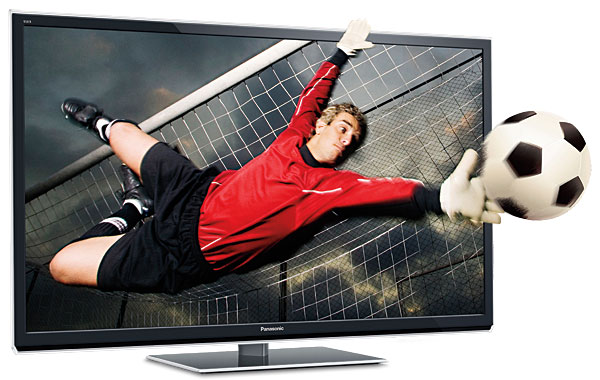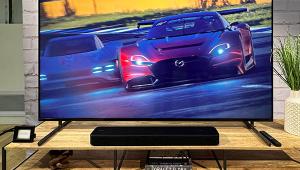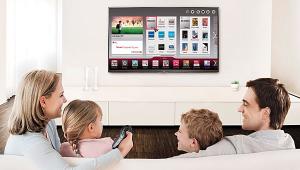Just the Facts: Flat-Panel HDTV Shopping & Tech Tips Page 2
3D comes in two forms:
Active-shutter 3D:
- The lenses in battery-powered LCD glasses open and close in succession to coincide with the left-eye image or right-image appearing on screen. An infrared (line-of-sight) emitter or Bluetooth (radio frequency) transmitter in the TV tells the glasses which eye should be active. Some glasses are rechargeable via the USB port on the TV, some use replaceable batteries.
- Since the full resolution of the screen is used for each eye, active-shutter 3D provides full HD (1080p) resolution to each eye vs half-resolution for each eye with passive glasses. (See below.)
- Active-shutter glasses are heavier than passive glasses, though they’ve gotten less bulky in recent iterations; ask to wear the glasses that come with your TV to gauge their comfort. 3rd party universal glasses are also available.
- Brightness is critical to a satisfying 3D viewing experience, and Active-shutter 3D tends to be less bright than passive glasses 3D because at any given moment only one eye is active.
- Active-shutter 3D glasses cost considerably more than passive 3D glasses. No more than one or two pair typically come with the TV (some come with none), and additional pairs can run from $50 to $100 or more.

Passive Glasses 3D:
- A special lens on the screen splits it in alternating lines to provide the left-eye image and right-eye image simultaneously. Polarized glasses, similar to those used in most 3D cinemas, keeps the images separate for each eye.
- Passive 3D glasses are lightweight and generally more comfortable to wear for longer periods than active-shutter glasses. They require no battery power, and extra pairs of glasses typically cost less than $10 each.
- Alternating black lines that separate the left- and right-eye image may be visible when sitting close to a large screen for passive 3D viewing. If you expect to sit relatively close to your HDTV, check 3D performance in the store from your viewing distance to determine if these are visible or bothersome. These lines do not appear while viewing regular 2D programming.
- Passive 3D tends to be brighter than active-shutter 3D, where the greater brightness of LED LCD technology often comes into play to counteract the loss of light from the glasses and other factors.
- Since the image for both eyes appears simultaneously on the screen, passive 3D provides only one-half of full HD (1080p) resolution to each eye. Despite what the numbers say, however, our observation has been that this lack of detail isn’t easy to detect and tends not to be an issue during viewing.
INTERNET TV
- Many so-called Smart TVs in the mid- to high-price brackets come with Internet connectivity to allow streaming of video or music services to the television and a connected sound system.
- Services offered vary by manufacturer and can change at any time as contract arrangements between the manufacturer and service expire. Check before you buy to insure the streaming services you subscribe to or use most frequently are available on your prospective HDTV.
- Many TVs come with built-in WiFi, although a wired Ethernet connection is usually preferable for streaming video.
- ARC, for audio return channel, appears as a feature of at least one HDMI connection on many new HDTVs. Mated with a compatible audio/video receiver, it allows sound from inbound streaming video and music services to be passed back to the receiver through the same HDMI cable that delivers video from the receiver to the display. Alternately, an optical digital audio cable can usually be run from the HDTV’s audio output to the A/V receiver.
FINAL SHOPPING TIPS
- Try to shop in a showroom with subdued lighting outside the glare of overhead store lamps.
- Anticipate that the default settings on the television you’re considering will not be optimized to provide the best picture; bright and garish is what attracts eyeballs in the retail environment. If you’re able, reset the TV temporarily to its “Movie” or “Cinema” picture preset, which will appear less bright and punchy, but will be closer to what you’ll get in your home in terms of color accuracy, black levels, and other critical image parameters. These modes usually also turn off motion interpolation and edge-enhancement circuits that give film-based content a video-like “soap opera” look and magnify the sharpness of the image at the expense of exaggerating video noise. Video noise reduction features, which can cause a loss of detail when turned up to their highest settings, are typically turned off or in a low setting in the Movie or Cinema mode.
- Look for a stable, clean image free of any exaggerated video noise, often evident as a kind of busy-ness in the pixels that makes them dance unnaturally when viewed close up. You want a smooth, film-like image, as long as it’s not delivered at the expense of detail. A 2D Blu-ray disc is by far the best source material you can use to judge image quality, provided it’s a good Blu-ray transfer (not all are; read Home Theater’s movie reviews if you’re unsure about a title).
- Don’t forget your mount or furniture needs. The time to budget for a wall mount and installation or a new TV stand or cabinet is before you shop. This is often money better spent than on the extended warranty that is often pitched aggressively by retailers.




















































